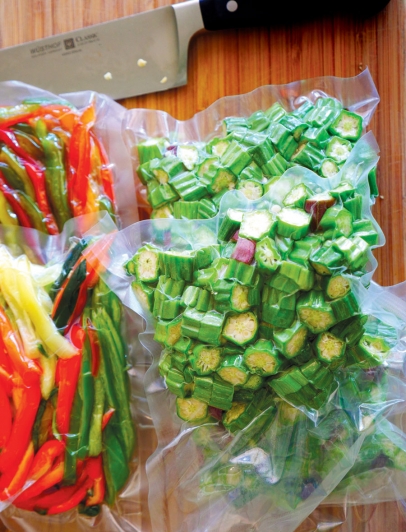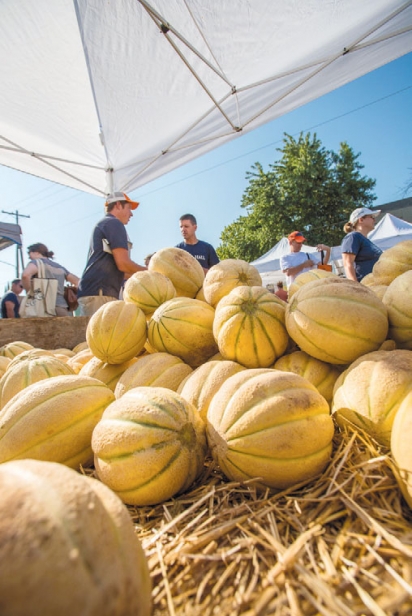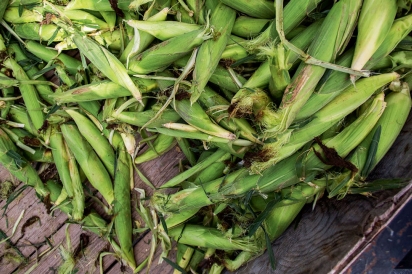Shopping the Season
To Savor and to Save This is the moment to enjoy and preserve summer’s bounty.
Glancing at the keyboard as I write this, I notice dirt under my fingernails. Earlier today I was rooting in my home garden, harvesting the last of the strawberries and covering my young tomato plants in expectation of the hail and severe storms rolling through tonight. By the time you read this, however, the chance of tornadoes will have dwindled to nearly nothing, and my little patch will be delivering a bounty of tomatoes, cucumbers and peppers.
My backyard garden can only produce so much, though, so I rely on our local farmers to supply the rest: corn, okra, melons, peaches, summer squash and the like. Oklahoma’s spring weather blesses us with a summer bounty, but what is best to buy now? What is one to do with it all? How do I store it? Cook it? Here are some suggestions.
What to eat now?
• Sweet corn: To select, a fresh husk is the number one thing to look for. Nice deep brown silk tips or ends mean it’s ripe, but the whole silk shouldn’t be dried up. Open the tip of the husk to see if the kernels grow all the way to the end of the ear; kernels should be plump and milky when pinched.
• Peaches: To select, look for fruit that is firm with a taut, unblemished skin and no signs of bruising or wrinkles. If you smell peaches when you walk up to the stand, you know they are ripe.
• Watermelon & cantaloupe: Choose a firm, symmetrical, unblemished melon with a dull rind, without cracks or soft spots, that barely yields to pressure. Some people swear by the “thump” test, but experts say that method is unreliable for determining ripeness.
• Summer squash and zucchini: Because it has a high water content, summer squash doesn’t require much cooking. Raw, it adds nice texture to a salad of greens or a crudités plate. Summer squash is a good source of fiber and vitamins A and C.
• Okra: Look for pods that are 2 to 3 inches long. Longer ones tend to be tough and fibrous. Store in the refrigerator for up to a week. Okra can be frozen, but when it is thawed it becomes most suitable for soup and gumbo.
• Basil: Basil is available year-round in supermarkets, but summer is the herb’s best season. To select, look for basil that isn’t wilted and doesn’t have dark spots. And if you’re growing your own, be sure to harvest it on a sunny day, as the sun will bring out the essential oils that won’t be present otherwise.
• Green beans: Pods should be cirsp and firm with no soft spots or signs of discoloring. Store in the refrigerator for up to a week.
• Plums: Feel for plums that yield slightly to the touch, but don’t squeeze them. Let the fruit sit in your palm. It should give a little. If you buy firmer fruit, though, don’t put it in the refrigerator or the kitchen window— put it in a paper bag in a dark place for a day or two. After the plum is picked, the sugar level remains the same, but the acidity falls, so it only seems sweeter.
• Eggplant: Store eggplant on the countertop—not in the refrigerator. Choose a spot that’s away from direct sunlight. Choose a container that allows for circulation, like a vented bowl or perforated bag. Peeling is optional for a standard globe or Japanese eggplant.
• Shell beans: Choose full pods that are just starting to dry. Keep in a bowl on the counter for two days or refrigerate in a loose bag up to a week.
• Tomatoes: See below.
Tomatoes tend to be the star of Oklahoma summers, so here are our top 10 tomato tips and tricks:
• Select tomatoes that are firm, but have a bit of give. Be sure they feel heavy for their size.
• Avoid tomatoes that are too soft, for they probably won’t make the trip home. Also avoid tomatoes with wrinkles, soft spots or black marks.
• Treat tomatoes gently so they won’t bruise.
• Don’t worry about tomatoes with weird shapes. Some of the best tomatoes we have had were not perfectly round.
• Sniff tomatoes—they should smell earthy and tomato-y.
• Unsure of the variety? Ask for a taste—most markets and farm stands are happy to cut one up for you.
• Store tomatoes on a plate at room temperature, never in the fridge or a plastic bag. We store them stem-down in a single layer on a paper towel or dish-towel-lined rimmed baking sheet.
• Tomatoes are delicious sliced on a sandwich, and they can also be broiled, marinated, pickled, grilled, roasted or sautéed.
• Our favorite tomato sandwich is nothing more than white bread, a slathering of homemade mayonnaise, sliced Heirloom tomatoes and flaked sea salt. You’ll need a napkin or two …
• Ripe tomatoes need little embellishment, and no cooking. Caprese salad is a good example of simplicity with maximum flavor: Toss sliced tomatoes with fresh basil and either torn fresh mozzarella cheese or creamy burrata, drizzle with high-quality olive oil and sprinkle with sea salt and freshly ground black pepper. Feeling fancy? Call it capriccio.
Extend the flavors of summer with smooth and savory vegetable soups. With summer’s bounty giving way to fall, a batch of quick and simple puréed soup is one of the best ways to take advantage of vegetables still on hand. Double the recipe for freezing and you’ll be ready to bring out a taste of summer when the leaves fall from the trees.
Follow these simple steps and you will be on your way to a delicious bowl of soup—no recipe required.
Pick your veggies and start chopping.
Start with either an onion, shallot or leek. Chop up your favorite summer veggie (or combination of veggies) into uniform chunks: carrots, tomatoes, zucchini, eggplant, peppers, corn, etc. You’ll need 3 to 4 cups. Don’t worry too much about size or shape, for everything will
Pick your fat and start cooking.
Melt something (butter, olive oil, coconut oil, bacon grease) in a large pot. Toss in your chopped onion and let it sweat for a few minutes to soften slightly, then add the rest of the veggies. Season with a good amount of salt, then continue to cook, stirring occasionally until the vegetables start to soften and release some of their juices. Add a little more fat to the pan if it seems too dry.
Pick your seasoning and start the flavor.
I like to throw in a few sprigs of fresh herbs. Whatever you have on hand will work: Thyme, parsley, rosemary and basil tend to play well with most vegetables. At this point I also like to add some dried spices so they can bloom in the hot fat: cumin, curry powder …
Pick your liquid and start simmering.
The only thing you really need is water, for it lets the true flavor of the vegetables shine through. If you are feeling fancy, however, deglaze the pan with a bit of wine and then add some vegetable stock (preferably homemade). It can be nice to finish with a little butter or cream as well.
Grab a blender and purée.
Remove any twiggy herb stems then either stick in an immersion blender and start whizzing or transfer the soup to a blender (in batches if necessary). If the soup seems too thick to purée, simply add more water, stock or cream. If you want to serve it cold, add some sour cream, yogurt or buttermilk to the blender (don’t heat the soup afterwards, for it can curdle).
Eat it up or pack it for another day.
Taste the soup for final seasoning—it may need more salt, pepper or a squeeze of lemon or a splash of vinegar. Serve it hot, warm or chilled. Transfer any extras to a plastic container and freeze for another day.
Don’t forget the toppings.
• Fresh herbs
• Drizzle of olive or truffle oil
• Toasted and chopped nuts
• Dollop of sour cream
• Toasted sesame seeds or pepitas (pumpkin seeds)
• Croutons
• Triangles of cheese toast or grilled cheese sandwich
10 Quick Corn Dishes
• To boil corn: Bring a large pot of salted water to a boil. Add shucked and de-silked ears of corn and cook until tender, about 4 minutes.
• To grill corn: Bruch shucked and de-silked ears with oil. Grill over high heat, turning often, until charred, 5 to 10 minutes.
• Bacon Grilled Corn: Wrap ears with a strip or 2 of bacon, then wrap each ear in foil. Grill 10 minutes, turning occasionally.
• Mexican Corn: Brush grilled ears of corn with mayonnaise; sprinkle with crumbled cotija cheese or grated parmesan, cayenne pepper and lime juice.
• Creamed Corn: Toss 3 cups raw corn kernels in 1 tablespoon flour. Cook in 2 tablespoons butter for 5 minutes. Whisk in 1 cup heavy cream and simmer until thickened. Stir in chopped chives, salt and pepper to taste.
• Corn Ice Cream: Bring 2 cups raw corn kernels and 2 cups cream to a simmer. Season with salt and cook 5 minutes. Cook slightly then purée with 1 cup sweetened condensed milk. Chill, then churn in ice cream maker.
• Corn Pizza: Brush pizza dough with olive oil. Top with sliced fresh mozzarella, raw corn kernels and grated parmesan. Season with salt and pepper. Bake until crust is crisp and cheese is melted. Top with basil and a drizzle of olive oil.
• Corn and Tomato Salad: Toss 2 cups raw corn kernels with equal amounts of chopped heirloom tomatoes and cucumbers. Top with a drizzle of olive oil, a squeeze of lime juice and chopped cilantro.
• Cut ears into quarters before boiling. Combine 1 stick of softened butter with 2 tablespoons chopped oregano, 1 teaspoon lightly ground fennel seed and the zest of 1 orange.
Toss boiled corn pieces with butter.
• Nestle raw corn kernels and a chopped jalapeño into a quesadilla filled with grated Monterey jack cheese.
Visit EdibleTulsa.com for more of our favorite summer vegetable recipes.






